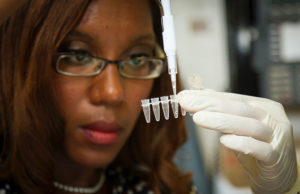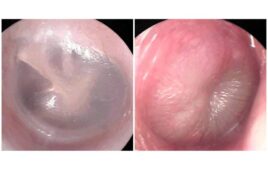Working through the regulatory requirements for IVD devices in your target markets can mean a successful launch into an industry segment poised for great growth in the coming years.
Claudia Sirch, Intertek

(Image courtesy of the National Cancer Institute)
In-vitro diagnostic (IVD) devices help detect diseases using samples from the human body, such as blood draws or mucus swabs. Examining these specimens provides essential information to identify, cure, treat or prevent illness. As populations age and pandemics such as COVID-19, SARS, and other infectious diseases sweep the globe, the IVD market is expected to grow, resulting in an increased demand for early and simplified diagnosis and rapid-test products.
IVD regulatory requirements
Global regulatory requirements for IVD products vary and often differ from requirements for other medical devices. In the U.S., Canada and Europe, requirements depend on product classification, which is based on risk level. Additionally, in Europe, the In Vitro Diagnostic Regulation (IVDR), for placing IVD products on the market came into force in May of 2017, replacing the IVD Directive (IVDD), with the transition ending in May of 2022. Changes under the IVDR include an expanded scope, reclassification of devices, and more stringent requirements regarding clinical evidence and documentation.
Local, regional and international standards can be used to demonstrate compliance with specific regulatory requirements for IVD devices. Examples include:
- IEC 61010-2-101, EN 13532 and/or ISO 15197 for safety of IVD medical equipment/self-testing devices.
- ISO 13485 for quality management systems.
- ISO 14971 for risk assessment.
- IEC 62304, IEC 62366-1 for software and usability.
- IEC 61326-2-6 for electromagnetic compatibility (EMC).
- EN 556 & ISO 11137, ISO 13408 series for performance, including sterilization and microbiological methods.
- Standards for labelling, metrological traceability, and more.
IVD and medical electrical equipment (MEE) standards
Selection of standards must be made carefully, keeping in mind specific regulatory requirements in the target market(s). For example, submissions to regulatory bodies for point-of-use or home-use products sometimes reference standards for medical electrical equipment like IEC 60601-1, IEC 60601-1-2 and IEC 60601-1-11. The FDA does not currently list IEC 61326-2-6 — the international EMC standard for IVD equipment — as a recognized consensus standard to which a Declaration of Conformity is accepted, but in the EU, EN 61326-2-6 is harmonized.
If manufacturers want to use a voluntary FDA consensus standard, the IVD device should meet the requirements of AAMI/ANSI/IEC 60601-1-2 for MEE to provide evidence for compliance with EMC requirements. Standards for MEE are in many aspects more stringent than those for laboratory equipment so manufacturers of IVD devices should identify the appropriate standards and apply their requirements from an early design stage.
The European Commission has asked the European Committee for Standardization (CEN) and its Electrotechnical body (CENELEC) to harmonize standards with the Medical Device Regulation (MDR) and IVDR, but the process has been slow. As a result, although the new IVDR supports the use of harmonized standards, they may not be available in time. Some manufacturers will have to take a different route to proceed, e.g. via standards harmonized under the IVDD or other state-of-art international or European standards.
An international standard for IVD medical equipment
The Third Edition of IEC 61010-2-101 was issued in 2018 and has been adopted and published as a national standard in the U.S. and Canada. It is used in conjunction with the general requirements for laboratory equipment covered by the Third Edition of IEC 61010-1:2010 and its Amendment 1:2016. Both are listed as standards operated in the IECEE CB Scheme, which is an international certification program that helps manufacturers to gain access to global markets.
IEC 61010-2-101 specifies the safety requirements for equipment intended for IVD medical purposes, including self-test IVDs. Its focus is on the risks related to the exposure of hazardous chemical substances, aerosol vapors, radiation and flammable liquids, which are addressed by specific requirements for construction, markings and documentation. For hazards not covered by the general and particular standards, risk assessment shall be carried out and documented using the requirements of ISO 14971.
Regulatory success
Given the number and variety of standards, the regulatory requirements for the growing IVD market may seem daunting at first. Manufacturers must first consider which market(s) they wish to take their products to, then identify the applicable standards and requirements for that market. Being familiar with the requirements for various markets will help. Partnering with a knowledgeable third party can also be beneficial.
Once the products and markets are identified, be prepared to conduct various checks and tests throughout the product development cycle. These might include pre-compliance checks, process evaluations, independent testing and product certification. Make sure all testing and results are well documented for the regulatory bodies. Navigating these requirements well can mean a successful launch into a market poised for great growth in the coming years.
Claudia Sirch is chief engineer for medical, laboratory, measurement and control equipment and laser products at Intertek. She has over 25 years of experience in the testing and certification business, and is a lead and technical assessor in the IECEE CB Scheme.
The opinions expressed in this blog post are the author’s only and do not necessarily reflect those of Medical Design and Outsourcing or its employees.




